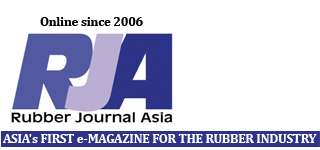World demand for natural rubber will probably slow through 2016 as consumption growth weakens in China, the biggest importer, curbing prices of the raw material used in everything from tires to medical gloves and condoms.
Expansion will moderate to 3.5 % in 2016 from 3.9 % this year and 4.1 % in 2014, according to Hidde Smit, former secretary general of the International Rubber Study Group. China’s demand will rise 4.8 % next year from 6 % in 2015 and 7.1 % last year, Smit estimates.
Futures have plunged 75 % from a record in 2011 as maturing trees in Asia boost latex production and China’s economy grows at the slowest pace since 1990. The slump in prices cut costs for tiremakers such as Goodyear Tire & Rubber Co. and spurred efforts by Thailand, Indonesia and Malaysia to restrain supply by limiting exports and felling trees.
“I foresee a continuation of the decline in growth rates in China over the coming years,” Smit said in e-mails last week. While the surge in new planting from 2005 through 2011 will boost world supply, consumption will grow at a much slower pace, said Smit, who headed the Singapore-based IRSG, an intergovernmental organization, from 2005 to 2009.
Futures in technically specified rubber used in the tire industry traded at $1.427 a kilogram in Singapore on Monday, down from a peak of $5.75 in February 2011. Prices may stay at about $1.50 to $1.60 through at least 2020, said Smit, an industry adviser. Futures averaged $2.54 in the past 10 years, data compiled by Bloomberg show.
Lower Costs
Goodyear, North America’s largest tiremaker, posted a record segment operating income of $1.7 billion in 2014, up 8 % from a year earlier, helped by lower raw material costs, the company said on Feb. 17.
Rubber prices slid 5.5 % this year, extending four annual losses. China’s economy has cooled as officials rein in local-government debt, crack down on graft and strengthen environmental laws. The targeted expansion of about 7 % this year would be the smallest increase since 1990.
“Slowing Chinese growth, particularly in a low inflation environment is a headwind for all industrial commodity demand, including rubber,” Colin Hamilton, head of commodities research at Macquarie Group Ltd. in London, wrote in an e-mail.
While Prachaya Jumpasut, managing director of The Rubber Economist Ltd., also sees global demand slowing, he says he expects production to expand at an even lower rate, resulting in a shortage of 470,000 tons in 2016.
Global Shortage
The world market will also have a deficit of 449,000 tons this year, the widest since 2000, which would cut inventories to 2.47 million tons from a record of almost 3 million tons in 2014, said Prachaya, a London-based industry adviser who has studied the market for more than 30 years.
Smit sees a decline in global stockpiles of 70,000 tons this year and an increase of 75,000 tons in 2016.
“I do not see this as a supply shortage but a correction on a rather high stock level at the end of 2014,” Smit said. “There will be a net stock build-up during 2016.” The Rubber Study Group in Singapore in January estimated a global surplus of 77,000 tons this year and of 51,000 tons in 2016.
Officials from Thailand, Malaysia and Indonesia, which account for two-thirds of global production, decided in November to limit exports in an effort to tighten supply. Thailand, the biggest shipper, is also buying rubber from farmers at above market rates to boost domestic prices and is encouraging farmers to cut down aging trees.
Global consumption will be 12.75 million tons next year from 12.32 million tons in 2015, while output will total 12.83 million tons from 12.25 million tons, Smit estimates. Use by China is poised to increase to 5 million tons in 2016 from 4.78 million tons this year and 4.51 million tons in 2014, he says. – Bloomberg

